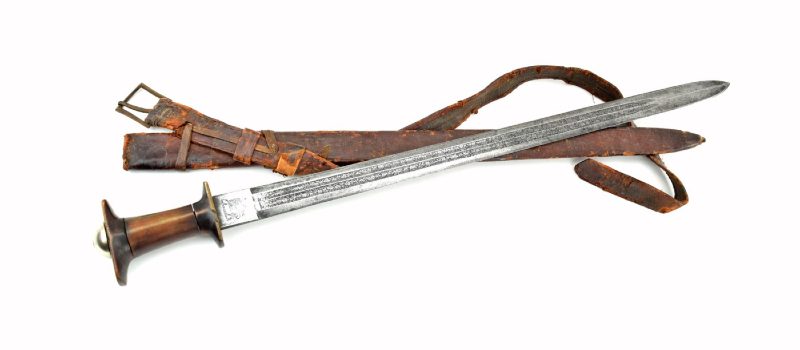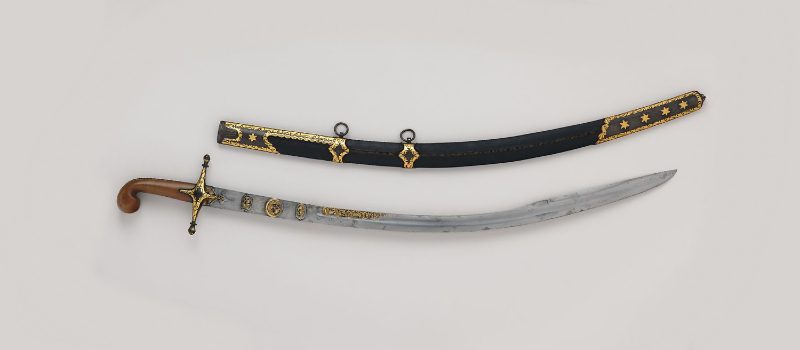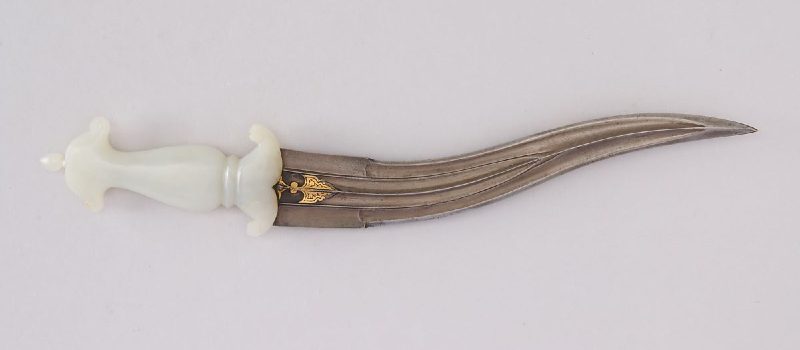Uncovering the Saif: A Study of the Arabian Sword Legacy
NO AI USED This Article has been written and edited by our team with no help of the AI

Most recognized for its peculiarly hooked pommel, the Arabian saif was one of the most fearsome swords in history. The Arabian Muslims were the founders of one of the great empires and used swords to conquer territories and spread Islam. Let us explore the history of the Arabian saif and what makes it unique among the other types of Islamic swords.
Characteristics of the Arabian Sword

Found in countries the Arabs have lived in, the saif varied in appearance throughout Islamic history. Here are the unique qualities of the Arabian
Type of Metal
The art of weapon making among the Arabs only developed after Indian steel was imported to the region. The ancient Indian steel was called the wootz steel, a high grade of carbon steel consisting of around 1 to 1.6 percent carbon. Swordsmiths also forged swords from steel imported from Serendib—modern-day Sri Lanka.
There were two kinds of Arabian swords based on metal: the saif anith, a blade made of iron, and the saif fulath or muzakka, a blade forged from steel.
Natural or Mined Iron
Swordsmiths used natural or mined iron and non-natural or manufactured iron in forging the swords. The mined iron has two types: the shaburqan and narmahin. The former is the hard iron that can be heat treated while the latter cannot. However, the iron lacked the hardness and solidity of steel blades.
Manufactured Iron or Steel
A manufactured iron is basically steel or fuladh, which means it is purified or refined. Bladesmiths added some ingredients to decrease the softness of the natural iron until it became flexible for heat treatment.
Local Iron or Steel
Some of the Arabian types of swords swords were native and forged from local iron. The Damascene was the iron produced and forged at Damascus, Syria, while the Khurasani originated from Khurasan—the modern-day region lying in northern Afghanistan, southern Turkmenistan, and northeastern Iran. When the Arabs conquered Egypt, the country served as a center for
Damascus Steel
The Arabian swords forged from manufactured steel generally show the watery pattern called firind or jawhar, which is the characteristic of Damascus steel. Steel swords forged from the Indian wootz steel also show the fancy firind pattern.
The pattern is the effect of the incomplete mixing of two components of steel in the crucible, which is the narmahin or soft iron and its water called dus. Comparatively, swords forged from natural steel won’t have the patterns.
Blade Shape
The early Arabian swords were straight but later evolved into the broad-bladed and slightly curved saber we know today. The sabre is slightly-curved and sharpened only on one side of the blade. As a saber type of
Size and Length
Although the size and length of the Arabian
Sword Mounting
Often carved from a solid piece of wood, the hilt of the Arabian
Facts About the Arabian Sword

The term saif, sometimes spelled sayf, is an Arabic word for
The early Arabian swords were straight and double-edged.
In coinage and sculptures, the earliest representations depict the Arabs with straight swords, not sabers. The Turkic warriors from Central Asia likely introduced the curved blades into the Islamic world during the reign of the Abbasid caliph al-Muʿtaṣim in the 9th century.
The Arabs wore their swords suspended from a shoulder belt.
The Arabs carried their swords on a belt strapped over both shoulders, similar to a baldric. Eventually, the Abbasid caliph al-Mutawakkil abandoned the use of the shoulder belt in favor of the waist belt. Still, its use retained its religious and ceremonial significance in later Islamic periods. Muslim ruler Nur al-Din and his successor Saladin readopted the custom.
Most information on the Arabian saif comes from Arabic literature.
The Arabian
Yemen was a major center of
The term scimitar refers to a curved
The scimitar refers to the curved swords originating from the Middle East, South Asia, and North Africa. However, the scimitar swords were also used in Europe after the Crusader and the Mongol campaigns in Eastern Europe.
The Arabs preferred Indian swords above all others.
The crucible steel
Since the Arabs only had an inferior type of iron ore available, they obtained Indian steel. Also, there were ancient trade connections between India and the Arabian Peninsula, so Indian swords likely came to the Arab world very early.
Several Arab countries produced excellent Arabian swords.
In the 4th century CE, the Yemen of the Himyarites influenced the art of weapon making. The tubba, the Muslim name for the kings of Yemen, even crafted armor themselves. The Yemenite was the best quality of all the antique swords. The Syrian city of Aryah also produced excellent swords. Today, some of the
Surayj and Khabbāb were the two popular swordsmiths in Arabia.
In Central Arabia, Surayj was famed for the quality of his swords, which were called the surayjī swords. The other swordsmith was Khabbāb, an early companion of the Prophet and a popular swordsmith in Mecca, a city in modern-day Saudi Arabia.
The Arabian Sword —and Other Types of Islamic Swords
The Arabian
1. Kilij

The Turks and the Ottoman Empire used the kilij during the 15th and 16th centuries. Unlike the Arabian saif, the Turkish Ottoman saber has a straight blade until the last third of its length which then angles sharply and becomes deep. The Ottoman
2. Shamshir

The shamshir began to exist around the 15th and 16th centuries in Persia. The Persian
3. Talwar

The talwar is a
4. Nimcha

Widely used in Algeria and Morocco, the nimcha is a North African
5. Jambiya

The Arabian dagger jambiya has a double-edged curved blade, often with a pronounced rib down the middle. However, each country has several modifications to the knife blade, hilt, and scabbard. In Turkey, the jambiya blades are often longer and not much curved. Some feature handles with large flat pommels while others are pistol-shaped and made of wood, ivory, or even jade.
6. Khanjar

The khanjar, sometimes spelled kanjar, is a dagger used in several countries for many different weapons. In India it is typically a large dagger with a very broad base and a slight curve. In Persia it is usually double-edged with a double curved blade and a pistol handle.
In some Middle Eastern cultures, the khanjar has a symbolic status and is part of the traditional dress in Yemen and the United Arab Emirates. It is not an uncommon wedding gift to the groom and to sons when they reach adolescence.
History of the Arabian Sword
The saif existed in Arabia before the 7th century, though little is known about the particular weapon. In the pre-Islamic period, the Arabs had their local warfare system often involving small battles among the tribes, not big armies.
Early Islamic Period
The Arabic literature mentions the Mashrafiya swords produced in Mu’tah, a city in modern-day Jordan. These Arabian swords were highly valued where Prophet Muhammad even ordered a raid to the city to seize them. During the time, Yemen was also a significant center for
In the 7th century CE, Islam became a religious and socio-political force in Arabia. After the death of Muhammad in 632, his followers, led by the caliphs, established their empire and continued the territorial expansion. The Arab forces used their swords in conquests of Iraq and Persia—modern-day Iran. They also took Syria, Egypt, and Palestine from the Byzantine Empire.
The Umayyad caliphate was the first Islamic dynasty centered in Damascus, Syria. As the dynasty’s capital, Damascus was also the trade center where caravans from the East and West exchanged their products. Fine swords from Persia or India were admired and sold to Europe and other Islamic countries.
Islamic Golden Age
From the 9th to the early 13th century, the Arabian saifs both double-edged and single-edged sabres co-existed. It is unknown exactly when or where the curved
Abandonment Period
By the late 13th century, the Arabian saif declined when invaders razed the remaining centers of
The Ottoman Empire had continued to use their curved swords known as kilij which eventually spread out from Turkey throughout the Middle East and Asia including India. Also, the Mughal invasion of Afghanistan and India brought the talwar to the region.
Conclusion
Like several medieval swords, the Arabian swords were fearsome battlefield weapons where several Arab countries produced excellent swords. However, the Ottoman kilij, the Indian talwar, and other Islamic swords displaced these swords. Today, the saif remains a significant part of Arabian history.





